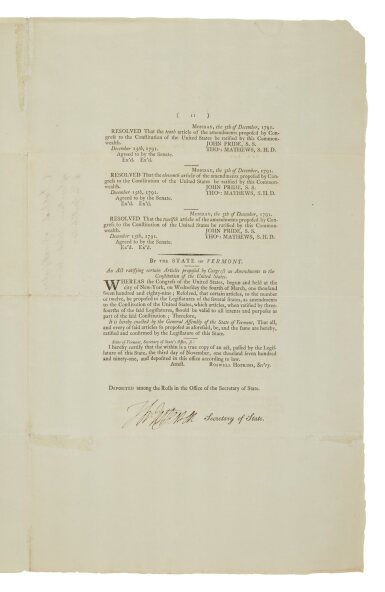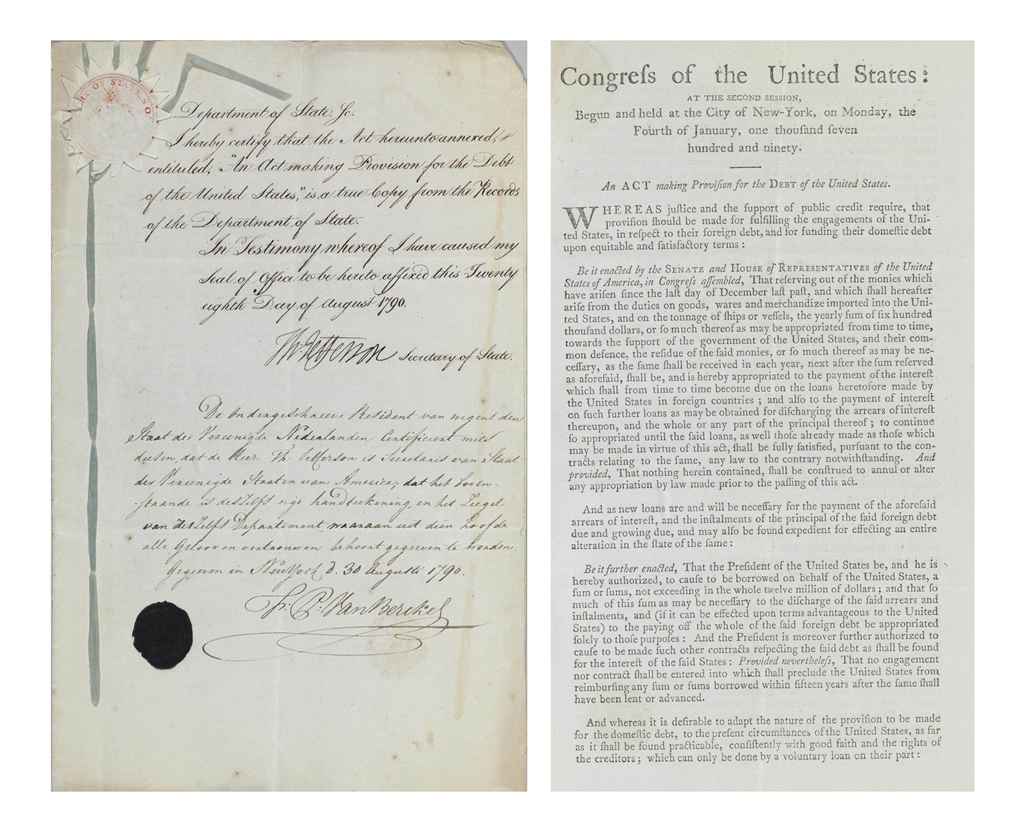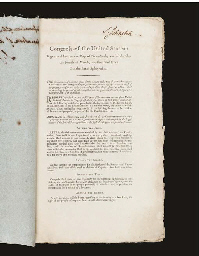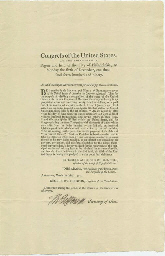JEFFERSON, Thomas. UNITED STATES, Second Congress. Printed document boldly signed ("Th: Jefferson") as Secretary of State, comprising An Act making Appropriations for the Support of Government for the Year [1792] . Philadelphia: Childs and Swaine, [1791]. 3 pages, folio , VERY FINE.
JEFFERSON, Thomas. UNITED STATES, Second Congress. Printed document boldly signed ("Th: Jefferson") as Secretary of State, comprising An Act making Appropriations for the Support of Government for the Year [1792] . Philadelphia: Childs and Swaine, [1791]. 3 pages, folio , VERY FINE. JEFFERSONIAN VERSUS HAMILTONIAN VISIONS OF THE NEW AMERICAN ECONOMY An rare printing, in fine conditionm of the United States Funding Act for the fiscal year 1792, signed by Jefferson, but containing the ideological imprint of Alexander Hamilton. Both defenders and critics of big government today might smile at the seeming petty scale of operations here in the third year of the government's existence. All of the federal government's spending are encompassed in three neatly printed pages (current editions of the budget weigh in at over 400 pages). The Act specifies three areas of expenditures: salaries and expenses of government officials, "the support of the military establishment of the United States," and debt service. The salaries of the President, Vice-President, Attorney General and the Justices of the Supreme Court total $53,000. The salaries of all House and Senate members total $129,000 (less than the annual pay of a single member today). There are some striking entries, such as the appropriation "for the payment of the annual grant to Baron Steuben, pursuant to an act of Congress," of $2500; an appropriation for $19,772.79 "for the additional expense of enumeration of the inhabitants of the United States"--the first census of 1790. And $1,000 "for the purchase of hydrometers for the use of the officers in the execution of the laws of revenue." The total cost of the Government's operation a relatively modest $600,000. But the key aspect of the budget is the national debt, and it was there that Hamilton and Jefferson fought their epic battles over both the scale of federal spending and the future of the American economy. The year before, in 1790, Hamilton issued his First and Second Reports on the Public Credit, calling for the federal government to assume state debts, and to redeem Revolutionary War debts at face value. More broadly, Hamilton envisaged a market-driven national economy that would enjoy the support of the powerful, city merchants and tie America's economic interests to the global power of the British economy. Jefferson, horrified at such schemes, wanted limited government, and local, self-contained economic markets infused with an agrarian spirit. In their famous bargain of 1790, Jefferson thought he'd bested Hamilton by trading his consent for the funding measures in return for uprooting the seat of government away from the corrupting cities of New York and Philadelphia and moving it to the Potomac. This document is an important piece of the ongoing battle between them. VERY RARE: We have only traced one other example of this key act of Congress at auction since 1975. Evans 23886 (citing the NYPL copy, also signed by Jefferson).
JEFFERSON, Thomas. UNITED STATES, Second Congress. Printed document boldly signed ("Th: Jefferson") as Secretary of State, comprising An Act making Appropriations for the Support of Government for the Year [1792] . Philadelphia: Childs and Swaine, [1791]. 3 pages, folio , VERY FINE.
JEFFERSON, Thomas. UNITED STATES, Second Congress. Printed document boldly signed ("Th: Jefferson") as Secretary of State, comprising An Act making Appropriations for the Support of Government for the Year [1792] . Philadelphia: Childs and Swaine, [1791]. 3 pages, folio , VERY FINE. JEFFERSONIAN VERSUS HAMILTONIAN VISIONS OF THE NEW AMERICAN ECONOMY An rare printing, in fine conditionm of the United States Funding Act for the fiscal year 1792, signed by Jefferson, but containing the ideological imprint of Alexander Hamilton. Both defenders and critics of big government today might smile at the seeming petty scale of operations here in the third year of the government's existence. All of the federal government's spending are encompassed in three neatly printed pages (current editions of the budget weigh in at over 400 pages). The Act specifies three areas of expenditures: salaries and expenses of government officials, "the support of the military establishment of the United States," and debt service. The salaries of the President, Vice-President, Attorney General and the Justices of the Supreme Court total $53,000. The salaries of all House and Senate members total $129,000 (less than the annual pay of a single member today). There are some striking entries, such as the appropriation "for the payment of the annual grant to Baron Steuben, pursuant to an act of Congress," of $2500; an appropriation for $19,772.79 "for the additional expense of enumeration of the inhabitants of the United States"--the first census of 1790. And $1,000 "for the purchase of hydrometers for the use of the officers in the execution of the laws of revenue." The total cost of the Government's operation a relatively modest $600,000. But the key aspect of the budget is the national debt, and it was there that Hamilton and Jefferson fought their epic battles over both the scale of federal spending and the future of the American economy. The year before, in 1790, Hamilton issued his First and Second Reports on the Public Credit, calling for the federal government to assume state debts, and to redeem Revolutionary War debts at face value. More broadly, Hamilton envisaged a market-driven national economy that would enjoy the support of the powerful, city merchants and tie America's economic interests to the global power of the British economy. Jefferson, horrified at such schemes, wanted limited government, and local, self-contained economic markets infused with an agrarian spirit. In their famous bargain of 1790, Jefferson thought he'd bested Hamilton by trading his consent for the funding measures in return for uprooting the seat of government away from the corrupting cities of New York and Philadelphia and moving it to the Potomac. This document is an important piece of the ongoing battle between them. VERY RARE: We have only traced one other example of this key act of Congress at auction since 1975. Evans 23886 (citing the NYPL copy, also signed by Jefferson).
.jpg)














Testen Sie LotSearch und seine Premium-Features 7 Tage - ohne Kosten!
Lassen Sie sich automatisch über neue Objekte in kommenden Auktionen benachrichtigen.
Suchauftrag anlegen